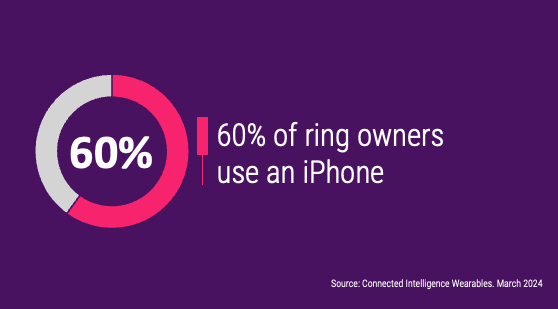
Oura preps for competition
Oura is by far the biggest competitor in the nascent smart ring market, but with Samsung’s impending launch, the company is coming under pressure. As a result, the company appears to be moving quickly to bolster its position and in recent weeks has expanded the ring’s functionality, as well as the company’s retail strategy. On the latter move, Oura’s ring is now available via Amazon, which is a significant retail expansion, and a much needed one. From a functionality perspective, the company last week added a new Pregnancy Insights feature that provides data and analysis for expecting moms.
The Circana Take:
- Oura is clearly going to face a new competitive reality once Samsung launches its ring and Oura needs to make the cost of this short period of time when it can ride the wave of additional smart ring awareness (caused by Samsung’s announcement) before Samsung actually launches its new device.
- While the new Samsung Ring will certainly increase competition for Oura, many people will only consider the Samsung option if they are already within the Samsung ecosystem. As a result, Oura’s core focus should be on Apple ecosystem consumers looking for additional health insights.
- The Pregnancy Insights feature offers a compelling solution. First time parents-to-be are likely willing to shell out the money for a smart ring – and the monthly service fee – in order to gain more data and advice about the pregnancy period. Of course, the real challenge will be convincing these same parents to keep wearing the ring once the baby is born.
AI meets Glasses
The Ray-Ban Meta glasses are getting more advanced AI features, turning what was initially a pair of sunglasses with audio and video recording capability into more of an augmented-realty solution that has long been the goal of various consumer tech companies. The glasses already had visual search capabilities (arrived in 2023) and a new beta feature can identify landmarks in some locations, telling you more about them. Meta CTO Andrew Bosworth showed off a few of these examples last week, such as a history of the “painted ladies” houses in San Francisco. The AI-driven answers are initially provided in text format, but Mark Zuckerberg showed off some other examples where the glasses responded with audio.
The Circana Take:
- AI + smart-glasses starts to take the new product in an interesting – and useful – direction, particularly with an increased focus on audio responses. This continues a long-term trend that we have been tracking with our Ecosystem report; namely that intelligent voice agents could become a far more important part of a consumer’s solution.
- If and when voice responses become more mainstream, there could be an impact on many other form factors – such as smartphones – that will no longer necessarily require a large screen as part of the design spec. Further, voice interfaces as the “core” user interface means a whole new era of landgrab for the tech industry, potentially shaking up the current two-OS, phone-driven landscape.
- Of course, it is still very early days for such a fundamental shift and realistically, we see this as a 5-10 year trend. And clearly all of the major players are investing in the voice market through their existing solutions. However, the addition of visual recognition (thanks to AI) combined with smart-glasses could become a key component of this future.